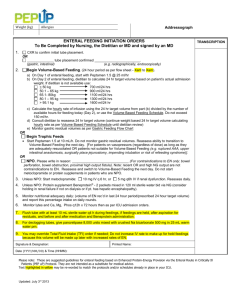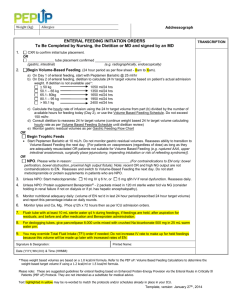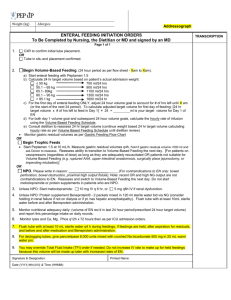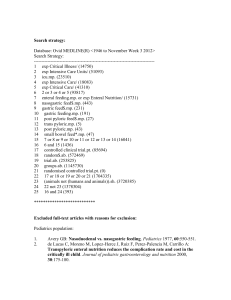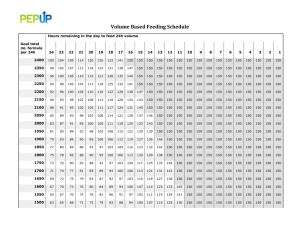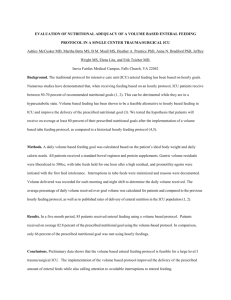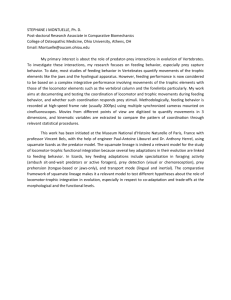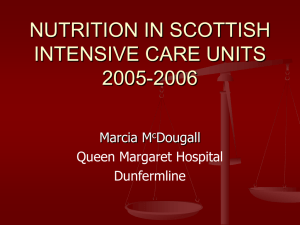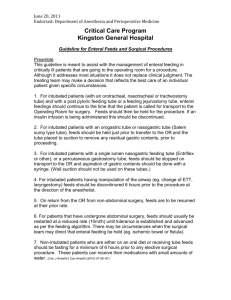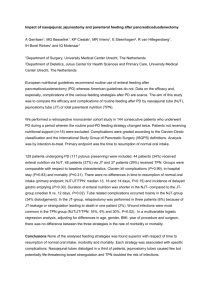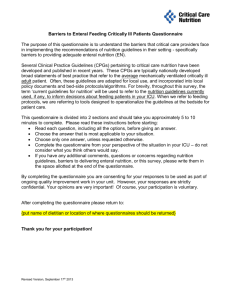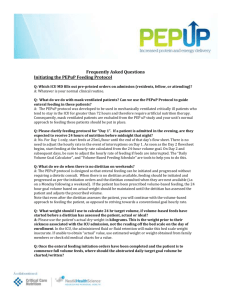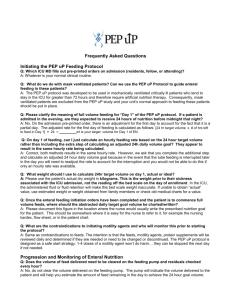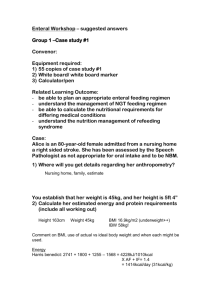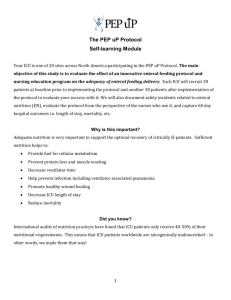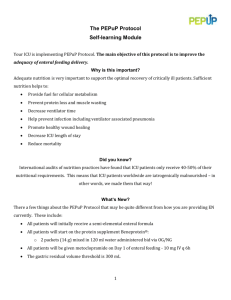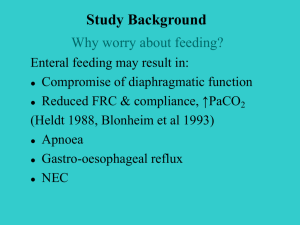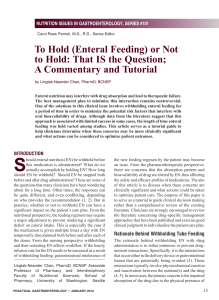InfoSheet_Nurses_28May2014
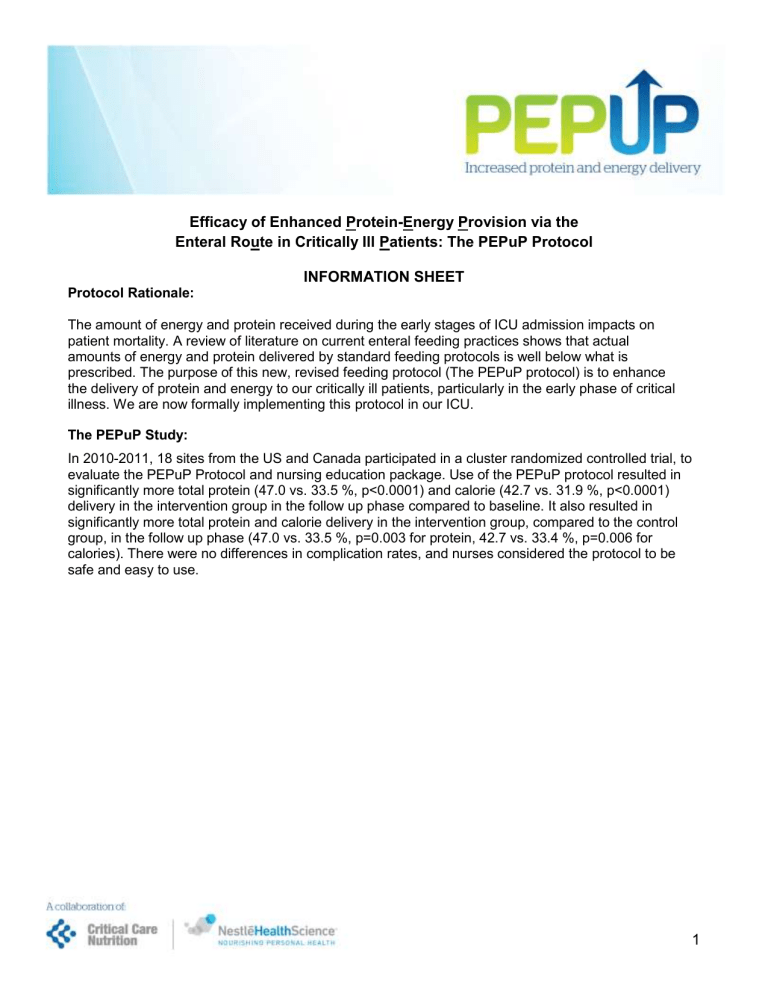
Efficacy of Enhanced Protein-Energy Provision via the
Enteral Route in Critically Ill Patients: The PEPuP Protocol
INFORMATION SHEET
Protocol Rationale:
The amount of energy and protein received during the early stages of ICU admission impacts on patient mortality. A review of literature on current enteral feeding practices shows that actual amounts of energy and protein delivered by standard feeding protocols is well below what is prescribed. The purpose of this new, revised feeding protocol (The PEPuP protocol) is to enhance the delivery of protein and energy to our critically ill patients, particularly in the early phase of critical illness. We are now formally implementing this protocol in our ICU.
The PEPuP Study:
In 2010-2011, 18 sites from the US and Canada participated in a cluster randomized controlled trial, to evaluate the PEPuP Protocol and nursing education package. Use of the PEPuP protocol resulted in significantly more total protein (47.0 vs. 33.5 %, p<0.0001) and calorie (42.7 vs. 31.9 %, p<0.0001) delivery in the intervention group in the follow up phase compared to baseline. It also resulted in significantly more total protein and calorie delivery in the intervention group, compared to the control group, in the follow up phase (47.0 vs. 33.5 %, p=0.003 for protein, 42.7 vs. 33.4 %, p=0.006 for calories). There were no differences in complication rates, and nurses considered the protocol to be safe and easy to use.
1
Tell me more about the PEPuP Protocol …
To be used in all mechanically ventilated adult patients, in whom you would normally initiate enteral feeding.
Goal is to start feeding within 24 hours of admission to the ICU.
Includes 3 options for feeding:
1. Volume Based Feeding: On day 1, feeds commence at 25mL/hr. Beginning on day 2, a 24 hour volume goal is prescribed and the bedside nurse has the latitude to determine the hourly rate based on what volume of feeds needs to be delivered over the 24 hour period.
Thus, if there is an interruption to the feeds due to a procedure or impending surgery, for example, the nurse can increase the rate over the ensuing hours to make up for the hours where feeds were not provided.
2. Trophic feeding: Enteral nutrition is delivered at a slow rate (10 mL/hr) and rate is not progressed.
3. Nil per os (NPO): If contraindication to receiving enteral nutrition
2
All patients receive a semi-elemental formula at initiation
All patients receive protein supplement (Beneprotein
®
) at initiation (unless NPO)
All patients prescribed metoclopramide at initiation (unless NPO)
Feeding option, enteral formula, protein supplement, and motility agents are reviewed daily
The dietitian will be asked to reassess the patient as soon as possible. The new order should include the volume of EN solution to be delivered in the remaining part of day and the amount to be delivered in the next 24 hr period. Prescription should read:
“Start (insert feeding formula) as per volume based protocol.
Target volume until 7am = (insert target volume)
24 hr target volume to begin tomorrow at 7 am = _____ mL /day”
Guidelines for Implementation:
There are several bedside tools available to help you implement the PEPuP Protocol.
Enteral Feeding Initiation Orders: You may be asked to assist the physician in completing the initiation orders. This form outlines which feeding option has been selected for the patient and if volume based feeding, the target volume to be used until the dietitian assesses the patient.
Gastric Feeding Flow Sheet: Used to monitor gastric residual volumes. The gastric residual volume threshold is 300 mL.
Volume Based Feeding Schedule: A guide for determining hourly rates of enteral feeding based on the volume of feed that needs to be delivered and the number of hours left in a 24 hr period. The maximum hourly rate of infusion is 150 mL/hr.
Nurses’ Guideline for the Management of Diarrhea: this reference sheet provides a guideline for potential causes of diarrhea and factors to consider in its management.
Daily Monitoring Tool: To be completed daily by the dietitian or nurse and used to monitor the progression of enteral feeding at the bedside. This web-based program creates graph to visually monitor the adequacy of nutrition delivered, calculates NUTRIC score to identify high risk patients, and offers prompts for strategies to improve enteral nutrition delivery.
3
At the end of each shift, double check the math to be sure your patient is on target to receive
24 hr volume of feeding and hand over the plan to the incoming nurse.
These bedside tools are meant to be a guideline and should not replace common clinical sense. If you are uncomfortable with what is being suggested, discuss with dietitian and/or attending physician or ICU fellow.
If you haven’t already done so, you will be invited to attend an in-service to learn more about implementing the PEPuP Protocol.
Thanks for your support and don’t hesitate to ask us if you have any questions.
4
